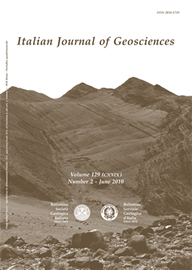
Geological map of the Corvillo and Mandre Basins (Caltanissetta Basin, Central Sicily): Explanatory notes
Rosanna Maniscalco(*), Giorgio De Guidi(*), Martyn Pedley(**), Giovanni Sturiale(*) & Mario Grasso(*)
(*) Dipartimento di Scienze Geologiche, Università di Catania, Corso Italia, 55 - 95129 Catania, Italy. Corresponding author: maniscal@unict.it
(**) Geography Department, University of Hull, Cottingham Road, HU6 7RX Hull (UK).
Volume: 129 (2010) f.2
Pages: 316-326
Abstract
In Sicily, the imbrication of the Apenninic thrust belt above the African foreland determined the progressive southward migration of marine basins that were shortened from the Middle Miocene until the Pleistocene. The area studied in detail is located in the Caltanissetta Basin, which was in fact, during Neogene times, a series of thrust-top basins (e.g. Corvillo and Mandre). The relationships between Neogene sedimentation and the synchronous development of fold and thrust structures are recorded by unconformities, lap relationships of strata, hiatuses. The stratigraphy of the substratum is dominated by varicoloured clays and siliciclastic deposits of Cretaceous-Early Miocene age. The thrust-top basin stratigraphy is represented by Tortonian siliciclastic deposits and evaporitic deposits, which are the product of the Messinian lowstand. The Early Pliocene flooding was responsible of deposition of chalks and marls and a later regional uplift produced a regression, during Late Pliocene times, with deposition of marls and sandstones. Compressional deformation acted continuously from Middle Miocene until, at least, Middle Pliocene, amplifying the pre-existing structures and creating differing styles of deformation depending on the lithologies involved.
Keywords
Central Sicily, Caltanissetta Basin, Corvillo and Mandre basins, evaporites, Neogene sedimentation, thrust-top basins, eustacy, tectonics.
Get Full Text